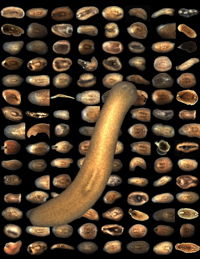Stem cells and regeneration: Opening up a new can of worms

Credit: Peter Reddien and Alejandro Sánchez Alvarado
Although they may look small and unassuming, planarian worms are famous in the scientific world for their extraordinary ability to regenerate body parts after injury. Even a small piece cut off a planarian can reorganize and regenerate to form a whole new worm. Now, scientists have completed the first systematic investigation of gene function in planarians, opening the door to using genetic analysis to decipher how regeneration works in this enigmatic animal. The research, published in the May issue of Developmental Cell, provides new insight into how individual genes control regeneration and may provide relevant information that further enhances the understanding of human development and health.
Planarian regeneration depends on a population of adult stem cells called neoblasts that have the potential to turn into any type of planarian cell. Although planarians and humans are not closely related, many of the genes found in planarians are also present in humans. Understanding what regulates regeneration and neoblasts in planarians may provide information about how stem cells may be used to replace diseased or damaged tissues in humans.
Dr. Alejandro Sánchez Alvarado and colleagues from the University of Utah School of Medicine, in particular postdoctoral fellow Dr. Peter W. Reddien, used RNA interference (RNAi) to identify specific genes required for regeneration and stem cell function in planarians. RNAi interferes with the process of protein synthesis by interrupting the transfer of protein-producing instructions contained in genes to the site in the cell where the protein is actually made. The gene is essentially silenced because, without delivery of the proper instructions, the protein it codes for never gets produced.
The researchers evaluated the physical defects that arose after inhibition of specific genes with RNAi in intact animals and on the proliferation of neoblasts in animals with amputations. As a result of these studies, candidate regulators of stem cells and directors of sequential steps of regeneration were identified along with genes that appeared to be critical for normal physiological processes.
“Our study demonstrates the great potential of RNAi for the systematic exploration of gene function in understudied organisms and establishes planarians as a powerful model for the molecular genetic study of stem cells, regeneration, and tissue homeostasis,” says Dr. Sánchez Alvarado. “Further characterizations of the genes and phenotypes identified in this study will help refine how individual genes within phenotype categories function to regulate regeneration.”
Media Contact
All latest news from the category: Life Sciences and Chemistry
Articles and reports from the Life Sciences and chemistry area deal with applied and basic research into modern biology, chemistry and human medicine.
Valuable information can be found on a range of life sciences fields including bacteriology, biochemistry, bionics, bioinformatics, biophysics, biotechnology, genetics, geobotany, human biology, marine biology, microbiology, molecular biology, cellular biology, zoology, bioinorganic chemistry, microchemistry and environmental chemistry.
Newest articles

Superradiant atoms could push the boundaries of how precisely time can be measured
Superradiant atoms can help us measure time more precisely than ever. In a new study, researchers from the University of Copenhagen present a new method for measuring the time interval,…

Ion thermoelectric conversion devices for near room temperature
The electrode sheet of the thermoelectric device consists of ionic hydrogel, which is sandwiched between the electrodes to form, and the Prussian blue on the electrode undergoes a redox reaction…

Zap Energy achieves 37-million-degree temperatures in a compact device
New publication reports record electron temperatures for a small-scale, sheared-flow-stabilized Z-pinch fusion device. In the nine decades since humans first produced fusion reactions, only a few fusion technologies have demonstrated…





















